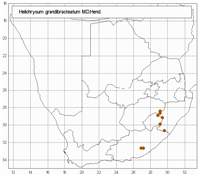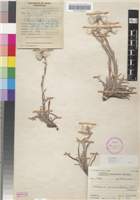Origin of name:
grandi = largebracteatum = bracts
Diagnostic characters:
Large headsCompact inflorescenceWhite bracts
Description:
Tufted perennial herb, stock stout (up to 10 mm diam.), woody, crowned with several leaf rosettes, flowering stems terminal, solitary, up to 200 mm high grey-woolly, leafy. Radical leaves up to 120 x 4 mm, cauline leaves much smaller, linear-lanceolate, apex acute, uppermost tipped with a white scale, base broad, clasping, glabrous above, silvery silky-woolly-felted below, striate from the strongly raised parallel veins, margins slightly involute. Heads homogamous, campanulate, 8�10 mm long, 18�20 mm across the fully radiating bracts, several clustered at the stem apex. Involucral bracts in c. 12 series, loosely imbricate, inner subequal, much exceeding the flowers, acute to acuminate, snow-white. Receptacle shortly honeycombed. Flowers 51�89, yellow. Achenes 1.5 mm, elliptic, with myxogenic duplex hairs. Pappus bristles many, equaling corolla, barbellate, bases cohering strongly by patent cilia
Flowering between September and November.
Distribution:
Grows scattered in poor stony grassland. Ranges from the Mont aux Sources area in NW. KwaZulu-Natal along the face of the Drakensberg and in the more elevated parts of KwaZulu-Natal and the Transkei to the Amatola Mountains, Katberg and Boschberg in the E. Cape. Relatively common in the KwaZulu-Natal Drakensberg between c. 1 800 and 2 600 m, but also recorded from the top of Swartkop (c. 1 350 m) overlooking Pietermaritzburg.
Grassland Biome.
Notes:
Sometimes forming conspicuous white patches of flowers in the veld.
Taxonomy:
Literature:
Helichrysum grandibracteatum M. D. Henderson in Bothalia 6: 422 (1954); Hilliard, Compositae in Natal 219 (1977).
Type:
KwaZulu-Natal, Bergville distr., Cathedral Peak Forest Research Stn., Killick 1149 (PRE, holo. K; NH, iso.).
Synonym(s):
Vouchers:
Hilliard 5177 (E; K; MO; NU; S); Hilliard & Burtt 10932 (E; K; NU); Wright 1048 (E; MO; NU).



